ASU researchers discover chameleons use colorful language to communicate

ASU researchers have discovered that color changes in chameleons convey different types of information during important social interactions. The lizards' body stripes and head colorings are particularly important during contests over territory and females.<br><br>Credit: Megan Best<br>
To protect themselves, some animals rapidly change color when their environments change, but chameleons change colors in unusual ways when they interact with other chameleons. Arizona State University researchers have discovered that these color changes don't happen “out-of-the-blue” — instead, they convey different types of information during important social interactions.
For example, when male chameleons challenge each other for territory or a female, their coloring becomes brighter and much more intense. Males that display brighter stripes when they are aggressive are more likely to approach their opponent, and those that achieve brighter head colors are more likely to win fights. Also, how quickly their heads change color is an important predictor of which chameleon will win a skirmish.
The results of the study are published online today in the journal Biology Letters.
Russell Ligon, a doctoral candidate in ASU's School of Life Sciences, and Kevin McGraw, an associate professor in the school, used photographic and mathematical modeling tools in new ways to study how the color change of veiled chameleons (Chameleon calyptratus) relates to aggressive behavior. They studied the distance, maximum brightness and speed of color change of 28 different patches across the chameleons' bodies.
“We found that the stripes, which are most apparent when chameleons display their bodies laterally to their opponents, predict the likelihood that a chameleon will follow up with an actual approach,” said Ligon. “In addition, head coloration — specifically brightness and speed of color change — predicted which was lizard was going to win.”
Chameleons typically have resting colors that range from brown to green, with hints of yellow, but each chameleon has unique markings. During a contest, the lizards show bright yellows, oranges, greens and turquoises. Interestingly, when the chameleons showed-off their stripes from a distance and followed that display with a “head-on” approach before combat, the important color signals on the striped parts of the body and head were accentuated.
“By using bright color signals and drastically changing their physical appearance, the chameleons' bodies become almost like a billboard — the winner of a fight is often decided before they actually make physical contact,” Ligon said. “The winner is the one that causes its opponent to retreat. While sometimes they do engage in physical combat, these contests are very short — five to 15 seconds. More often than not, their color displays end the contest before they even get started.”
This is the first study of its kind. The research team took pictures of color standards and estimated the sensitivity of different photoreceptors in their cameras. Then, they used information on the physiology and sensitivity of the photoreceptors of chameleons, and were able to measure the colors actually seen by the lizards. Though this method has previously been used to quantify static (unchanging) coloration, this study is the first to quantify rapid color change while incorporating the visual sensitivities of the animals under study.
There are approximately 160 species of chameleons in the world. Veiled chameleons (Chameleon calyptratus) are native to the Arabian Peninsula – specifically Yemen and Saudi Arabia. They are omnivorous and live essentially solitary lives except when mating. Many chameleons are at great risk, as destruction of their habitats is occurring at alarming rates.
The study was funded by an ASU GPSA grant and by individual sponsors.
The School of Life Sciences is an academic unit of ASU's College of Liberal Arts and Sciences.
Media Contact
More Information:
http://www.asu.eduAll latest news from the category: Life Sciences and Chemistry
Articles and reports from the Life Sciences and chemistry area deal with applied and basic research into modern biology, chemistry and human medicine.
Valuable information can be found on a range of life sciences fields including bacteriology, biochemistry, bionics, bioinformatics, biophysics, biotechnology, genetics, geobotany, human biology, marine biology, microbiology, molecular biology, cellular biology, zoology, bioinorganic chemistry, microchemistry and environmental chemistry.
Newest articles

Properties of new materials for microchips
… can now be measured well. Reseachers of Delft University of Technology demonstrated measuring performance properties of ultrathin silicon membranes. Making ever smaller and more powerful chips requires new ultrathin…

Floating solar’s potential
… to support sustainable development by addressing climate, water, and energy goals holistically. A new study published this week in Nature Energy raises the potential for floating solar photovoltaics (FPV)…

Skyrmions move at record speeds
… a step towards the computing of the future. An international research team led by scientists from the CNRS1 has discovered that the magnetic nanobubbles2 known as skyrmions can be…





















